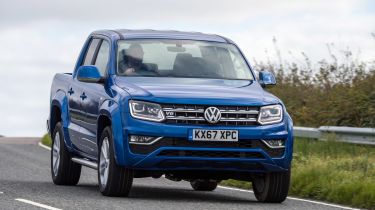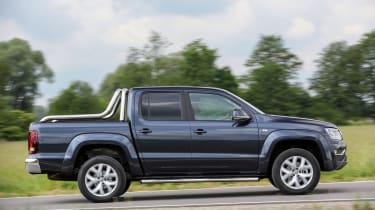Volkswagen Amarok pickup - Engines, drive & performance (2011-2022)
Heavy weight compromises the speed and handling of the Volkswagen Amarok
If you’re used to driving a normal car, then the Volkswagen Amarok is going to feel pretty big at first, but the upside is that its raised driving position gives you an excellent view of the road, making it surprisingly easy to place accurately. You have to realise that this vehicle has been designed primarily as a workhorse, so it doesn’t offer the car-like driving experience of many modern SUVs.
The Amarok’s weight and dimensions also don’t help when it comes to driving the big pick-up. Its steering doesn’t feel very responsive, and if you go into a corner quickly you’ll notice plenty of body lean, not helped by the fact that the Amarok is so tall, at 1,830mm. Still, it never feels anything less than safe and predictable, while the strong brakes inspire confidence. On the plus side, at slow speeds the steering is extremely light, so the car is easy to manoeuvre when parking.
The VW Amarok has been designed for a working life, so the suspension is tuned to cope with a variety of loads. As a result, it can become rather bouncy when you're not carrying heavy items in the load bed, although the Volkswagen doesn’t suffer this quite as badly as some rivals. The Mercedes X-Class offers a smoother ride, even when unladen, thanks to its more car-like coil-spring rear suspension; the VW sticks with traditional leaf springs.
With a raised ride height and four-wheel drive the Amarok is as capable off the road as on it. However, if you are planning to regularly take your VW into the rough then it’s worth considering the optional underbody protection and locking differential, which gives even greater traction in slippery conditions. Chunkier tyres will be worth considering for off-road enthusiasts, too.
More reviews
A combination of permanent four-wheel drive and an automatic gearbox is standard on the other versions (Highline and Aventura) regardless of whether you choose the 201bhp or 255bhp engine. The automatic transmission is smooth enough and certainly suits the Amarok’s easy going character. And while you can flick the gearlever to the left and take manual control of the gearchanges, the transmission is so good when left to its own devices you’re unlikely ever to bother.
Volkswagen Amarok diesel engines
With its big 3.0-litre capacity it’s no surprise to find the Amarok is reasonably brisk on the road. Even the 201bhp automatic can sprint from 0-62mph in a claimed 9.1 seconds, but it’s the 255bhp model that really impresses; it can do 0-62mph in 7.4 seconds, which is quicker than a sports car such as the Toyota GT86.
On the road all versions of the V6 feel smooth and exceptionally powerful, allowing you to make rapid yet effortless progress. And while the unit can get a little noisy under hard acceleration its deep growl is far more pleasant than the thrashy mechanical noise of four-cylinder rivals.
Yet while the V6 engines are muscular, it’s a bit of a shock to discover they can only tow a maximum of 3.1 tonnes - the Ford Ranger has a much more usable 3.5-tonne limit.













